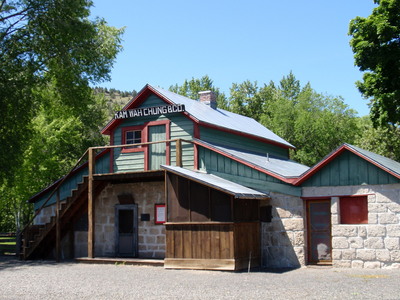Culture
As soon as substantial numbers of Chinese immigrants began to arrive in Oregon, the discriminatory laws and attitudes by the white community in combination with the “bachelor” society that formed in part due to laws that prohibited women from immigrating, accounted for the emergence of Chinatowns and the continued tradition of forming organizations and associations to act as surrogate families.
Organizations and Associations
In China, social organizations and associations were common and were usually based on surname, lineage, and native-place. In Oregon, the associations formed within the state were determined by surname. Generally, people with shared surnames were in the same group, although there could be exceptions. The Jung Wah Association, Portland’s consolidated benevolent association, was vital to the city’s Chinese population. It was a means to maintain traditions; it assisted its members with securing employment and organizing legal assistance against discrimination by hiring white lawyers; and it served as a voice for the community.
Secret societies, known as tongs in the United States, also formed within Chinese communities. These groups, while offering similar support structures as the mainstream organizations and associations, banded together in order to provide local communities with protection. It was the tongs that sought justice when the legal system discriminated against the Chinese.
Maintaining Traditions, Religion, and Culture
Chinese communities throughout the state continued their religious practices, traditional celebrations, and made sure to educate future generations on both.
Common religions included Buddhism and Taoism and temples called joss houses were built in locations Baker City, John Day, and Portland. These joss houses could be both stand alone structures, such as a two-story brick building erected in Baker City in the 1880s, as well as small shrines within other buildings, such as the altar in the Kam Wah Chung building in John Day. In Portland Taoist temples were located in buildings above local business and served as both religious and social gathering sites.
Holiday celebrations were also opportunities for social gatherings. The New Year’s Festival celebrations were very popular and included decorating buildings, lighting firecrackers, dancing, and playing music. As a means of maintaining culture in future generations, some communities such as Astoria and Portland had Chinese schools so that children could learn the language, character writing, and their heritage.

The Kam Wah Chung and Co. building is the only surviving remnant of John Day, Oregon’s once thriving historic Chinatown. The building is now a State Heritage Site and is open to the public.
Photo Credit: Tom Banse
Chinatowns
Chinatowns emerged wherever there was a strong presence of Chinese immigrants, such Portland and Astoria as well as Eastern Oregon towns including Canton City, John Day, Baker City, and Auburn. Within these communities, traditional religious and cultural practices were more easily maintained since they were apart from the prejudice white community. While some white owned business refused service, Chinese owned businesses in Chinatowns not only provided services and supplies, they sometimes offered foods and items shipped from China.
Gambling, opium, prostitution, and theatre were common within Chinatowns and often caused friction between the Chinese and white communities. During the late 1880s and early 1900s, the City of Portland passed numerous ordinances in attempts to suppress these activities. In 1881 for example the city passed an ordinance prohibiting opera performances after midnight due to the noise, but the Chinese community protested and as a comprise, the theatre limited the number of instruments played after midnight.
Unfortunately, with a decrease in the Chinese population and lack of jobs, especially the more rural areas in the state, many Chinatowns soon diminished by the mid 20th century leaving only a small fraction of what once was.
~~~~~~~~~~~~~~~~~~~~~~~~~~~~~~~~~~~~~
For more information on Oregon's Chinese History: Dreams of the West: A History of the Chinese in Oregon, 1850-1950. Portland: Ooligan Press, 2007. "Jointly created by the Chinese Consolidated Benevolent Association, history students at Portland State University, and the student staff of Ooligan Press."
